Hello America!
RCA’s Radio Leap in Belfast Changed Global Communication Forever
Belfast Makes Radio History
By Megan Pinette, BHS&M President
March 14, 2025 marks the 100th anniversary of the history making first live trans-Atlantic long-wave radio broadcast from London, England to the experimental Radio Corporation of America’s station in Belfast, Maine. This broadcast, relayed from the experimental RCA station located off Congress Street, paved the way for full global communication
My introduction to the mystery surrounding the old RCA radio station was through Mr. Bruce Clark. Bruce was inquiring at a Belfast Historical Society meeting in 2000 whether anyone had heard of or remembered the radio station. Rumor had it that the back section of the Belfast Armory was part of that station and had a room with walls lined with copper. No one seemed to have an answer and the subject faded back. At this meeting Bruce presented the Museum the RCA Reception (QSL) card that came from Les Salisbury, nephew of RCA engineer Frank Smith. At the time, this seemed to be the only known evidence of the RCA plant in Belfast. An “old time radio” related website claimed that there was no trace of the RCA station located here today. That sent up a red flag to our local radio enthusiasts and the search for traces of the station began in earnest in May 2003.
Through the diligent work of Bruce Clark of Belfast and Mr. Harry Nelson, of Newport, Maine and the geodetic survey technician for the Maine Department of Transportation, the Belfast Historical Society Museum is now the home of dozens of artifacts found at the site. These “Raiders of the Lost Station”, armed with aerial photographs, maps, GPS locators, metal detectors, and shovels, braved mosquitoes, swamps, poison ivy, and unsavory characters in their two-year quest to document the history of the station.
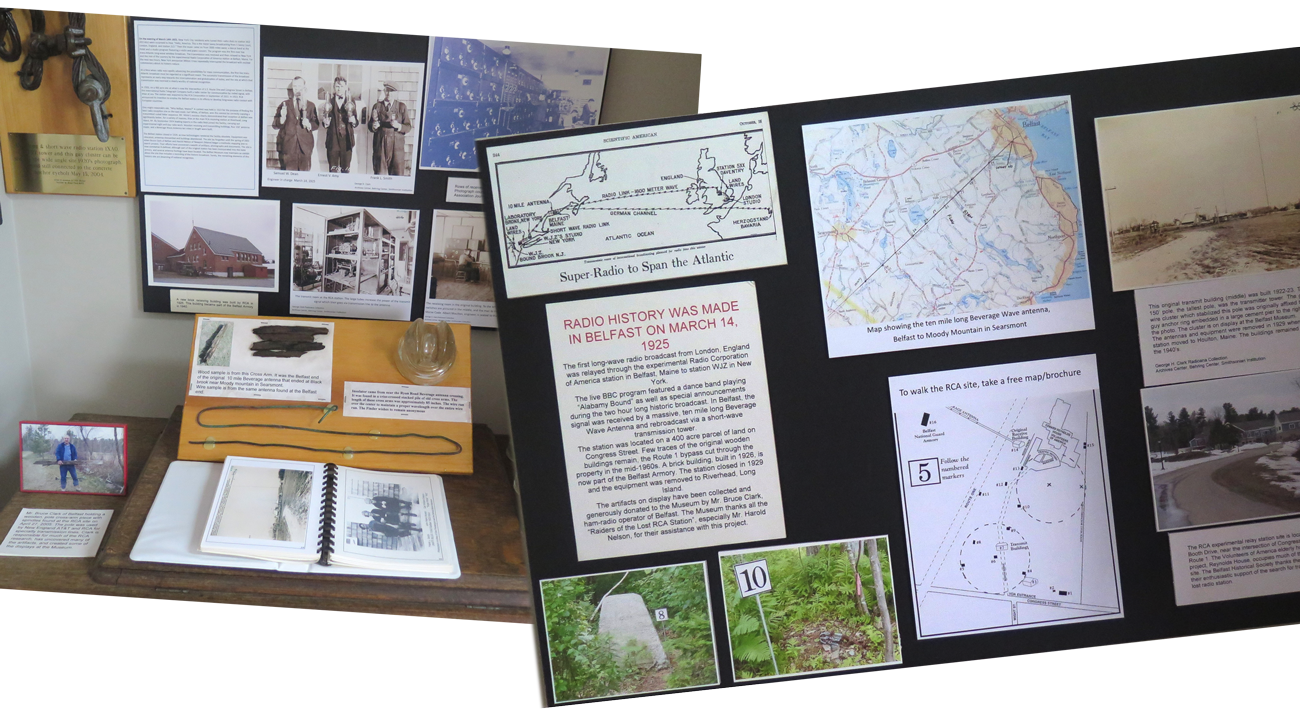
The museum now houses an extensive collection of printed material, photographs, artifacts, and even a recording of that first transmission. A museum exhibit was created in 2005.
The Story Begins in 1893 on North Haven Island with the Birth of Harold Beverage
Even at a young age, Harold was showing signs that he was not destined to become a farmer like the rest of his family. He attended the University of Maine, Orono, graduating in 1915 with a Bachelor of Science degree in Electrical Engineering. Beverage played a very important role in antenna development in the early 1920’s and was Chief Research Engineer for the fledgling Radio Corporation of America. He developed the “Beverage Wave Antenna” at Otter Cliffs, Maine on Mt. Desert Island. This radio station received the first word that the Armistice was signed, ending World War I. In 1920, the International Radio Telegraph Company built a radio center for working signals from ocean liners at sea. Coded messages were relayed to telegraphic facilities in New York.
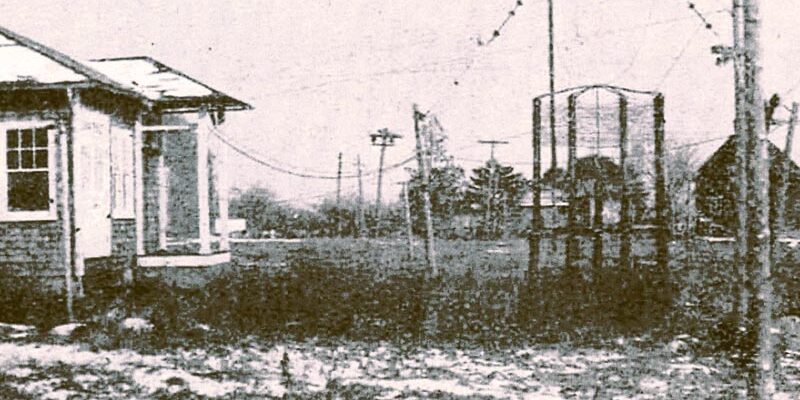
For European signals, as in the case at Belfast, Beverage’s long wave antenna, was only 20 feet off the ground and strung along poles stretching ten miles from Belfast to the foot of Moody Mountain in Searsmont. The antenna consisted of two parallel wires on cross arms on utility poles. At first, this was the only Beverage antenna, however, two more were added in 1926, Waldo to West Searsmont, and Stantial Brook in Knox to Thurston’s Corner in Freedom. All three were connected with wires on similar poles from Knox back to Belfast.
In the November 4, 1920 edition of the Republican Journal, it was announced that the International Radio Telegraph Company was busy constructing an operating building on newly acquired property on Congress Street. A crew was at work pouring the cement foundation, setting cement bases for the antenna masts and bungalows in the vicinity were leased to the crew of woodchoppers employed to cut over the property. By January 1921, the building was complete with instruments and equipment being installed. It is stated that a half dozen men will be on duty at the station which will be used as a ship-to-shore communications device. This station, with its 400 acres of land, was acquired by the RCA Corporation in September 1921. One month later, in October, David Sarnoff, General Manager of RCA paid a visit to Belfast to look over his latest acquisition to the growing RCA family. By 1923, it is announced that the intention of RCA is to develop the Belfast plant and make it a permanent affair, “one of the best outside their New York plant.” Five or six engineers were due in May with efforts aimed to develop long-wave radio contact with European countries through the Belfast relay station.

Why Belfast, Maine?
Why Belfast should have been selected as the virtual center of international affairs is neither a great nor deep mystery. It appears that a contest was held in 1923 and 1924 to find the best radio reception site in America. Mr. Earle B. White, Searsport Ave., Belfast, won the contest by correctly copying a transmitted letter sequence. This proved to RCA engineers that the reception of European signals was very much better at Belfast than at the main receiving station at Riverhead, Long Island. It was also determined that there were twice as many thunderstorms, which caused static interference, in the Riverhead area than in Belfast. The European signals were 30% louder in Belfast than in New York.
During the first summer of operation, the Belfast station proved quite satisfactory and was called upon to relay almost continuously. Hundreds of Morse code messages were received daily through the relay station. Signals were sent via a short-wave radio link to Riverhead and then via existing telegraph lines to the traffic office in New York City. The short-wave signal was achieved by means of a 6000-watt transmitter and 4, 150-foot-tall guyed radio masts. The Beverage Wave Antenna from Belfast to Lassell Cemetery in Searsmont received the signals.
By September 1924 experts in the radio field including Harold Beverage at Riverhead Long Island, and Clarence Hansell (Engineer) at Belfast, and L.B. Smith (Marconi Company) conducted experiments on transmitting on a Beverage Wave Antenna, finding it didn’t really have an improvement over a dipole antenna.
During this time radios have become prevalent in American homes and are providing entertainment to a rapt audience. Broadcast schedules for the evenings’ line-up appear in the newspapers on a daily basis. Radios are relatively inexpensive and advertisements in local papers read “Radiolas, the foremost step in radio receivers. $35, $65, $90 and up to $280, in stock. A Radiola for every purse. Yours truly, Fred D. Jones & Sons.”
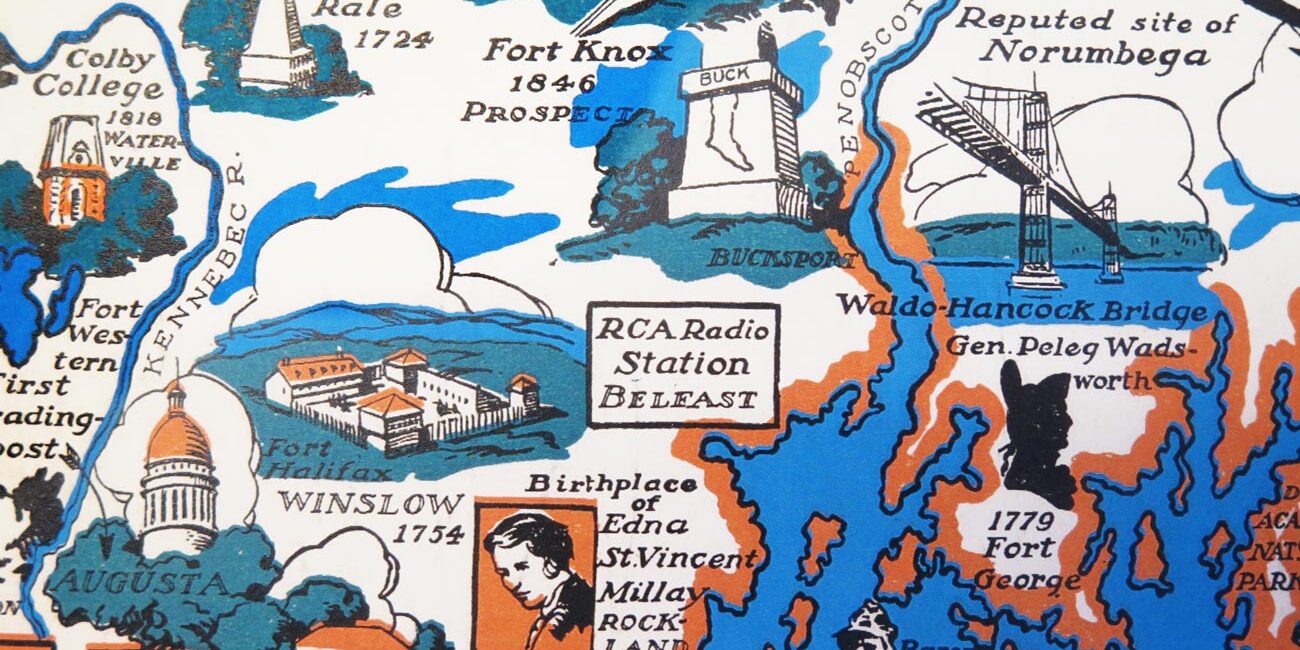
Radio the ‘Wave’ of the Future
International Radio Week began in 1923. American broadcasters would shut down their stations for a couple of hours so radio listeners could see if they could pick up powerful European stations. Then European broadcasters shut down and listened for American stations. American listeners would flood the switchboard of the New York Times telling correspondents what they heard, and the paper published the results the next day. Up until November 1924, not much new was happening. But in the spring of 1925, David Sarnoff had an ace up his sleeve (my opinion). The Times reported that there would be some experiments done by RCA regarding European radio broadcasts. On the night of the 13th of March, it was just squeaks and howls, but then on the evening of March 14th 1925, that a successful broadcast of a live trans-Atlantic, long-wave transmission was made. It was the first time in history that American broadcasting stations provided entertainment from across the ocean and it may well be said that the way has now been opened for the establishment of an international radio broadcasting service.
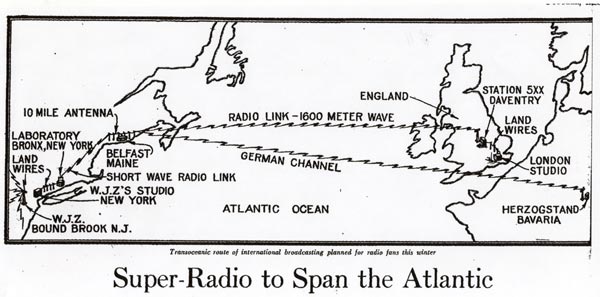
According to Harry Nelson, “At 6:15 (pm), David Sarnoff and RCA, including the men at work in the Belfast Plant that evening, knocked New York City on it’s ear.” Listeners who tuned their dials to WJZ on 455 khz were surprised to hear, “Hello America, this is the Hotel Savoy broadcasting from 5 Savoy Court, London, England, Station 2LO.” Then the music came on, from 3000 miles away: a dance band at the hotel, and a studio program featuring a violin and piano. The program was interspersed with excited commentary by New York radio announcer, Milton Cross for the next two hours.
The powerful BBC transmission originated from station 2LO of London, England, sent by land wire to station 5XX Chelmsford, and received by Belfast, which then relayed the transmission via short-wave to the RCA experimental station at Van Cortland Park. From Van Cortland Park the program was sent via land lines to stations WJZ and WRC. This spurred the building of High-Powered Longwave Radio Stations in Europe, and for the next 4 years, until shortwave radio had the bugs worked out of it, Waldo County Beverage Antennas and the Belfast Plant relayed European radio to America.
Work continued at Belfast for four more years. In 1926, a new “modern” steel and brick building was erected on the site and operations were moved to the new plant. This remained in operation until 1929, when RCA announced it would close its Belfast operation. Equipment and men were relocated to the station in Riverhead, Long Island. The brick building, as well as the smaller wooden structures built in the early 20’s, were abandoned. The poles to the Beverage antenna were removed by farmers and placed along roads since Central Maine Power had agreed that if poles were put up, CMP would run the powerlines., the copper wire spooled carelessly, and glass insulators tossed about. New technology and the stock market crash forced the closing.
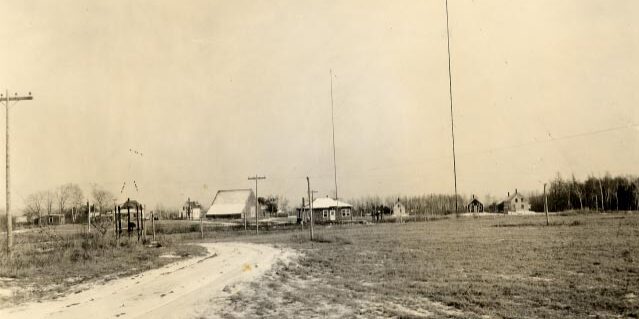
In July 1941, a lengthy article in the Republican Journal described the abandoned brick station as “left there in the field for nine years. Sixty thousand dollars worth of land and buildings lay idle and unused.” The brick building featured many windows, locker rooms, showers and wash rooms. This building found a new life, when the City of Belfast purchased the property and gave it to the State of Maine in order to build an armory for the Maine National Guard Third Battalion, 103rd Infantry, Company K. The 1926 station was incorporated into the new facility.
The Continued Slow Disappearance of the Original Site
In 1962, the Maine State Highway Commission built the new Route 1 by-pass routing traffic outside of downtown Belfast to a new bridge also under construction. This road cut through what was once the receive building and roadway of the RCA station property. In 2002 construction began on an elderly housing project, Edward Reynolds House, funded by the Volunteers of America. During their site prep work, several of the concrete piers came to light. We are fortunate that the re-kindled interest and search for the station began at this same time. The VOA housing authority has been extremely helpful and encouraging of the ongoing efforts to bring artifacts from the station to the surface once again.
First Transcontinental Radio Broadcast!
Milton Cross, an announcer in New York, breaks into the broadcast to explain how the music is coming from London to be broadcast in New York and Washington DC.
(44 seconds)
A Welcome From the London Announcer – Can make out a couple of words?
(18 seconds)
Music Sample 1 from the broadcast.
(16 seconds)
Music Sample 2 from the broadcast.
(13 seconds)
Read! Waldo County Amateur Radio Association's post: RCA in Belfast.
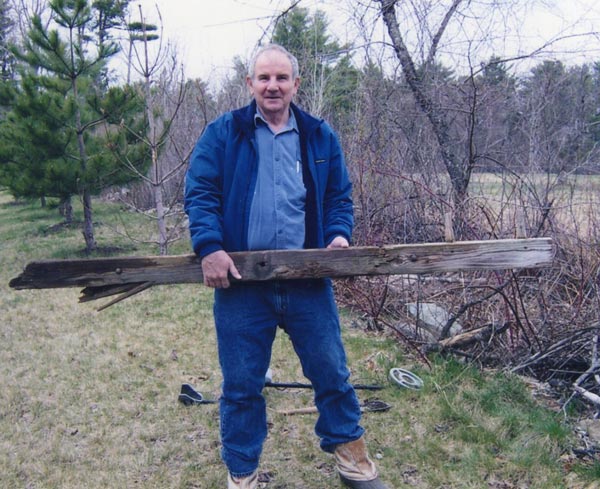
We owe a great debt of gratitude to Bruce Clark, K1FZ—HAM radio operator—and Harry Nelson, geodetic survey technician with the Maine DOT, for their dedication in preserving and documenting this rich history, which now allows us to celebrate the 100th anniversary.
Unfortunately, Bruce passed away on December 26, 2024, ending the twenty-five-year collaboration with the Belfast Historical Society & Museum. Harry continues his in-depth research into not only the Belfast RCA station, but the old IT&T Belfast station and is currently assisting the North Haven Historical Society create a Harold Beverage exhibit in 2026.
Harry Nelson spent some time with Bruce Clark at his home on Patterson Hill. Bruce had a Beverage Antenna hooked to his HAM radio, and demonstrated how his 2-wire antenna could bring in radio operators on one antenna and then cut them out by switching directions of the Beverage.
